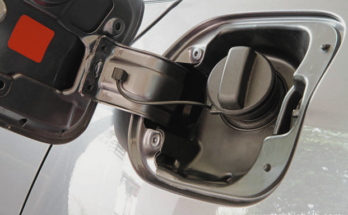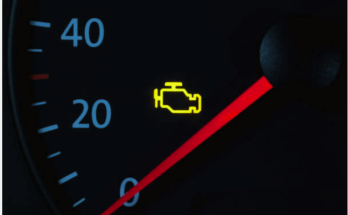The P0420 code is a diagnostic trouble code (DTC) that appears when there’s a problem with the efficiency of the catalytic converter in a vehicle’s exhaust system.
This code is part of the On-Board Diagnostics II (OBD-II) system, which monitors emissions-related components and systems.
When the check engine light illuminates and the P0420 code is detected, it indicates that the catalytic converter is not performing as efficiently as it should be.
The catalytic converter plays a crucial role in reducing harmful emissions by converting pollutants like carbon monoxide and hydrocarbons into less harmful substances.
Several factors can contribute to the appearance of the P0420 code, including catalytic converter failure, oxygen sensor issues, exhaust leaks, engine misfires, and fuel system problems.
Diagnosing the specific cause of the code requires a systematic approach and the use of diagnostic tools.
Once the underlying issue causing the P0420 code is identified, appropriate action must be taken to address it. This may involve replacing the catalytic converter, repairing exhaust leaks, addressing engine misfires, or maintaining the fuel system.
Overall, understanding and addressing the P0420 code is crucial for maintaining vehicle performance, emissions compliance, and fuel efficiency. If you encounter this code, it’s advisable to consult with a qualified mechanic or automotive technician to diagnose and resolve the issue promptly.
DTC Code: P0420 Description: Catalyst System Efficiency Below Threshold (Bank 1)
What are the possible causes of P0420 Code?
Catalytic converter failure is a leading culprit behind the P0420 code. These components can degrade over time due to normal wear and tear, exposure to extreme temperatures, or contamination from engine oil or coolant leaks.
When the catalytic converter fails to function properly, it can trigger the P0420 code by failing to adequately reduce harmful emissions.
Another common cause of the P0420 code is oxygen sensor issues. Oxygen sensors, particularly the downstream sensor located after the catalytic converter, play a critical role in measuring exhaust gas composition.
If these sensors malfunction or provide inaccurate readings, it can lead to the triggering of the P0420 code.
Exhaust leaks are also known to contribute to the appearance of the P0420 code. Any leaks in the exhaust system, such as cracks or holes in the exhaust pipes or manifold, can disrupt the proper functioning of the catalytic converter.
These leaks allow unfiltered air to enter the system, affecting the converter’s ability to effectively reduce emissions.
Persistent engine misfires can also trigger the P0420 code. When the engine misfires, unburned fuel enters the exhaust system, causing the catalytic converter to overheat and degrade prematurely.
This can lead to the triggering of the P0420 code as the converter fails to operate efficiently.
Finally, fuel system problems can play a role in the appearance of the P0420 code. Issues such as malfunctioning fuel injectors or a failing fuel pressure regulator can disrupt the air-fuel mixture ratio, affecting the performance of the catalytic converter.
What are the possible P0420 Code Symptoms?
When the P0420 code is present in a vehicle, it may manifest through various symptoms, although these can vary depending on the specific cause and severity of the issue. Some possible symptoms associated with the P0420 code include:
Check Engine Light: The most common symptom of the P0420 code is the illumination of the check engine light on the dashboard. This serves as a warning to the driver that there is a potential issue with the vehicle’s emissions system.
Decreased Fuel Efficiency: A malfunctioning catalytic converter can lead to decreased fuel efficiency, as it may not be effectively converting pollutants in the exhaust gases. This can result in the vehicle burning more fuel than usual to achieve the same level of performance.
Rough Engine Performance: In some cases, the presence of the P0420 code may cause the engine to run rough or hesitate during acceleration. This can be attributed to an imbalance in the air-fuel mixture or incomplete combustion of fuel in the engine cylinders.
Unusual Exhaust Odors: A failing catalytic converter may emit unusual odors from the exhaust system, such as a rotten egg smell, due to the buildup of unburned fuel or other contaminants in the exhaust gases.
Excessive Exhaust Smoke: A malfunctioning catalytic converter can lead to an increase in exhaust smoke, which may appear darker or thicker than usual. This can indicate incomplete combustion of fuel or the presence of contaminants in the exhaust gases.
Increased Emissions: The presence of the P0420 code may result in increased emissions from the vehicle, as the catalytic converter may not be effectively reducing pollutants in the exhaust gases. This can lead to environmental harm and may result in the vehicle failing emissions tests.
It’s important to note that not all vehicles will exhibit all of these symptoms when the P0420 code is present. Additionally, the severity of the symptoms may vary depending on the specific cause of the issue and the overall condition of the vehicle
How to fix the P0420 Code?

Fixing the P0420 code involves a systematic approach to identify and resolve the underlying issue affecting the catalytic converter’s efficiency. Here’s a detailed explanation of the steps to fix the P0420 code:
Diagnose the Problem: Start by using a diagnostic scanner to retrieve the specific trouble codes stored in the vehicle’s computer system. This will help you pinpoint the exact issue triggering the P0420 code.
Inspect the Catalytic Converter: Conduct a visual inspection of the catalytic converter. Look for physical damage such as dents, cracks, or discoloration, which could indicate internal damage or clogging affecting its efficiency.
Test Oxygen Sensors: Oxygen sensors play a crucial role in monitoring the exhaust gases’ oxygen levels. Use a multimeter or scan tool to test the upstream and downstream oxygen sensors’ voltage readings. Replace any sensors that are malfunctioning or providing inaccurate readings.
Check for Exhaust Leaks: Inspect the entire exhaust system for leaks, paying close attention to the exhaust manifold, catalytic converter, and exhaust pipes. Even small leaks can affect the catalytic converter’s performance. Repair any leaks using appropriate methods such as welding or using exhaust repair tape.
Address Engine Misfires: Engine misfires can lead to unburned fuel entering the exhaust system, which can damage the catalytic converter. Diagnose and repair any underlying issues causing engine misfires, such as faulty spark plugs, ignition coils, or engine control module (ECM) issues.
Maintain the Fuel System: The fuel system plays a vital role in engine performance and emissions control. Inspect the fuel injectors, fuel pressure regulator, and fuel pump for any issues. Clean or replace any components that are not functioning properly to ensure proper fuel delivery and combustion.
Replace the Catalytic Converter: If the catalytic converter is found to be faulty or damaged beyond repair, it will need to be replaced with a new one. Ensure to use a high-quality replacement part that meets or exceeds OEM specifications.
Clear the Error Codes: After addressing the underlying issue, use a diagnostic scanner to clear the error codes stored in the vehicle’s computer system. This will reset the check engine light and allow you to monitor the vehicle’s performance for any further issues
Note: By following these steps and properly diagnosing and addressing the underlying cause of the P0420 code, you can ensure your vehicle’s catalytic converter operates efficiently and maintains compliance with emissions regulations. If you’re unsure about any aspect of the repair process, it’s advisable to consult with a qualified mechanic or automotive technician for assistance
Conclusion
Addressing the P0420 code is crucial for maintaining both the performance and emissions compliance of your vehicle. By diagnosing and resolving the underlying issue affecting the catalytic converter’s efficiency, you can ensure optimal fuel efficiency, reduced emissions, and overall engine health. Whether it’s replacing a faulty catalytic converter, repairing exhaust leaks, addressing engine misfires, or maintaining the fuel system, taking prompt action is essential.




